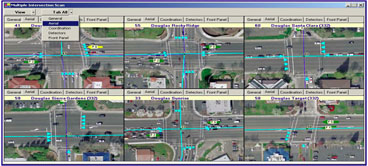Advanced Traffic Management Systems (ATMS) makes available complete, accurate and timely information in support of traffic operators and to benefit drivers. In its’ advanced form, it enables the automation of traffic monitoring and regulation on the network in real-time.
This approach to traffic management in turn requires a long-term view, currently underdeveloped, about how the roadway will be used and operated for different markets and locations. The benefits of automated networking apply under normal operational conditions and where there is abnormal, degraded or emergency working. For normal conditions, it can optimize traffic flow, energy use and power demand, use information gained from intelligent transportation and infrastructure and advanced position monitoring systems. Where other conditions apply, the decision support capability can optimize for a different policy and help return the network to normal operation. Customer information systems will feed off traffic management systems, providing reliable and up to date information to passengers and users.


Automation, once delivered, will in any case need to incorporate a fully optimized traffic management layer to realize its full potential. An array of technologies will be required to support this approach to automated traffic management, including accurate reporting, consistent geographic referencing systems, driver advisory systems, operational communications systems and real-time viewing, in addition to the modeling software.
Progress and early insights
To take these ideas forward, the ‘Next Generation Traffic Management’ (NGTM) program, as a first step, is building the economic case for the provision of whole system traffic management, including this ‘traffic management layer’ using a systems modeling approach.
Typical infrastructure requirements:
Communication Server – The Communication Server handles all the input and output to the field devices. The Communication Server can provide up to 512 simultaneous connections. Also, up to 9,999 devices can be configured on any port.
Communication Equipment – The Communication Server has been designed to handle many types of communication media. Current implementations of communication through radio, fiber, FSK modems, cable, dial-up modems, direct and ISDN modems. Any combination of equipment can be used with the Communication Server.
Field Devices – A vast number of devices can be controlled through the NTCIP or other Protocol. Currently supported devices; TS2, TS1, 170, 2070, Pagers, Pan/Tilt/Zoom Units, CMS, Real-Time Switches, and Incident Management Devices.
File Server – The File Server can be any network server that supports TCP/IP using NT Server, Novell, Unix, and Banyan.
Server – An agency can setup a separate machine that can handle all Traffic Responsive and Adaptive operations with the field.
TMC Server – The TMC Server allows center to center NTCIP access to surrounding area Traffic Management Centers.
Dial-In Access – Users can dial-in to a separate server or directly into the communications server.
Internet Access – Provides data in ASCII, HTML and GIF formats. By setting up a WEB Server data can be viewed by anyone in the world. System security can be setup ensuring that only data the agency wants to provide will be accessible.
Video Server – Separate equipment can be setup to provide projection maps and all client-side data.
